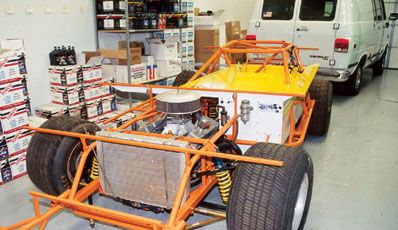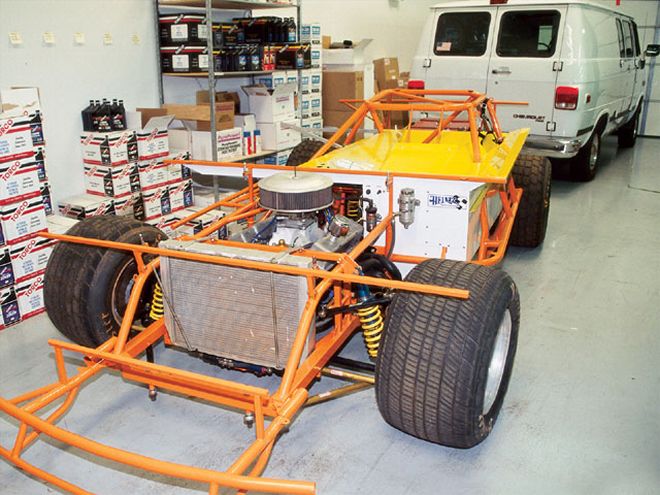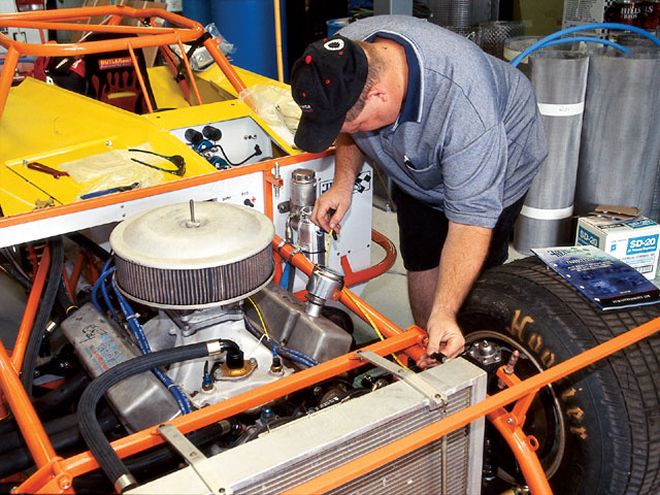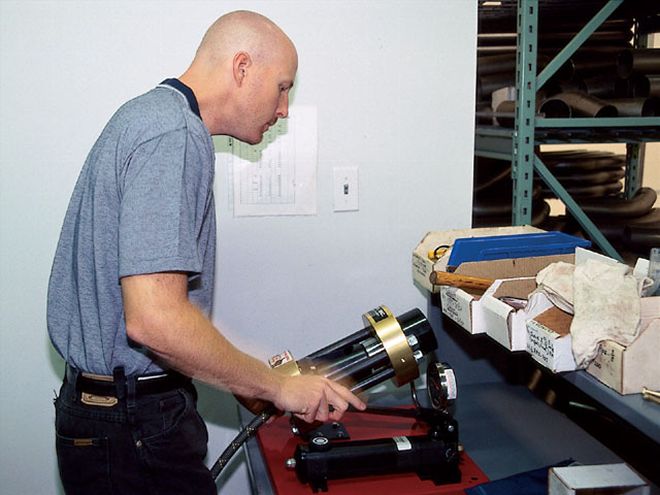
Click Here For Hose Statistics
 Our installation car is a new dirt Late Model chassis that has already been outfitted with all the necessary hardware except sheetemetal.
Our installation car is a new dirt Late Model chassis that has already been outfitted with all the necessary hardware except sheetemetal.
Even if you are racing in a class with minimum weight limits, the weight of individual components is always critical. The more pounds you can shave off the car, the more lead you will have available to move about the car as a tuning tool. One area where the opportunity to shave a little weight is often missed is the various plumbing lines run throughout the car. It may not seem like much at first glance, but when you add it all up there's over 40 feet of tubing running through the typical stock car with a dry-sump oiling system. Fuel lines, oil lines, coolant lines, power steering, the list goes on.
Light is Right That's why several different companies have developed lightweight hoses for racing purposes. XRP (Xtreme Racing Products) calls lightweight hoses the HS-79 line. It's a smooth-bore Teflon hose that is not only lightweight, it's also fire resistant and features an extra large inside diameter (id) compared to standard steel-braided hoses for increased fluid flow. Also, for more abrasion and fire resistance, the hoses can be purchased with a protective coating, known as Hypalon.
The biggest drawback to this stuff? It's expensive-as much as twice the cost of regular steel braid. But it also represents a significant weight savings-although the exact amount varies depending on the size of the hose, weight savings average around 50 percent. It's up to you to decide where this fits on your priority list.
HS-79 has a thin wall but is still resistant to collapse because of it's multi-layered construction. The interior wall is Teflon, which is in turn surrounded by a silicone outer tube, a layer of wire-braid reinforcement, and finally a Nomex(r) outer braid. Hypalon, if ordered, is the final layer. It's also slightly more flexible than conventional steel-braid hoses. (Note: As a general guideline, if a plumbing hose is forced into a bend so tight that its circular shape begins to deform or flatten out, you've gone too far.) The Teflon inner hose makes it suitable for all engine fluids, including gasoline, alcohol, or nitromethane.
 We don't have any old hoses to go by, so Junior Hampton takes careful measurements making sure the tape measure follows the intended path of the hose.
We don't have any old hoses to go by, so Junior Hampton takes careful measurements making sure the tape measure follows the intended path of the hose.
Get To Work To get a better idea of how lightweight hoses should be installed we traveled to Heintz Performance in Concord, North Carolina, to watch the guys in the shop perform a complete plumbing install on a dirt Late Model. Located in the heart of stock car country, Heintz Performance sells and installs lightweight hoses for a number of Cup, Busch and Truck teams as well as the Saturday-night racer. The car they were working on when we arrived is a new dirt Late Model chassis that a team plans to run locally. The race team has already installed everything but the sheetmetal, which makes it easier to run everything exactly where it needs to go.
The first step is to make sure all of your racing hardware is exactly where you want it. This includes the fuel cell, oil tank, oil pump, remote filter, coolant reservoir, etc. It's not impossible to move these items later, but it probably will mean cutting or buying new lines. If you are doing a complete plumbing install like we are, it's a good idea to do each system individually. Break them down into what they carry-fuel, oil, or water-and work on one until that circuit is complete. That way you can concentrate on each system and make sure the fluid flow is efficient (and you don't miss anything).
Click Here For Hose Statistics
 Scott Heintz uses XRP's special press to crimp the fittings in place.
Scott Heintz uses XRP's special press to crimp the fittings in place.
Fittings for the HS-79 hose use lightweight collars that require a special crimping device. The fittings themselves come in the standard sizes (-4, -6, -8, -10, -12, -16, and -20) and with a good choice of bends (straight, 30, 45, 60, 90, 120, 150, and 180 degrees). When sizing the hoses we used a tape measure, bending the tape to follow the intended path of the hose. Keep in mind when measuring hose lengths which fitting you intend to use, as they have different lengths themselves. This should not be much of a problem though, because you generally want a bit of slack in your lines. Take, for example, the radiator hoses. Say you get in a wreck and push the radiator over. If the lines are tight, no movement is allowed before things start breaking. But if there is room for the hoses to move with the radiator, it can save you on the repair bill and potentially allow you to finish the race.
Heintz Performance recommends smooth-bore, non-convoluted hoses because they do not disrupt fluid flow and are much easier to clean. Everybody has their own methods for cleaning hose lines, but ours in this case was pretty simple. Because the hose is new, we only wanted to make sure no debris had collected in the hose, so we flushed each with brake cleaner (keeping a careful eye on what came out of the hose) and then dried it out with a shot of clean, dry air from an air hose. Attachment is the same as any other plumbing system. The fittings are all aluminum, and AN wrenches work perfectly. Do not use Teflon tape or any other thread sealer because it isn't the threads on these fittings that create the seal. Rather, it's a 37-degree flare that's the mating surface. You can, however, use a drop or two of oil on the threads to keep them from galling because of aluminum-to-aluminum contact.
Finally, remember that AN racing fittings are aluminum and do not require a lot of torque to tighten. You do not want to crank down on these like there's no tomorrow, or damage will be the result. That, by the way, is one of the reasons why AN wrenches have short handles.
For the complete install we used slightly over 43.75 feet of lines-a mixture of standard and Hypalon, depending on location, and sizes from -6 to -16. Total cost was $1,500 (compared to approximately $750 if we had gone the standard route). Calculated weight savings were greater than five pounds.
The Tale Of The Tape
Want to know more? We thought so. Here's how XRP's lightweight HS-79 stacks up to conventional steel braided hose (XRP's specifically). Note that these figures do not include the lightweight fittings.
Manufacturer
XRP
Dept. CT01
5630 Imperial Hwy.
South Gate, CA 90280
562/861-4765